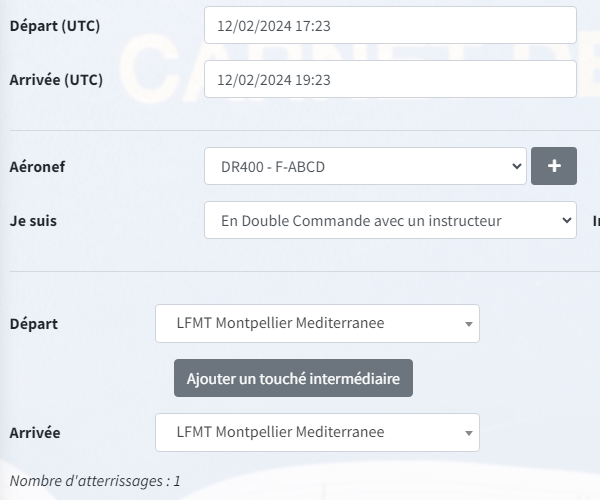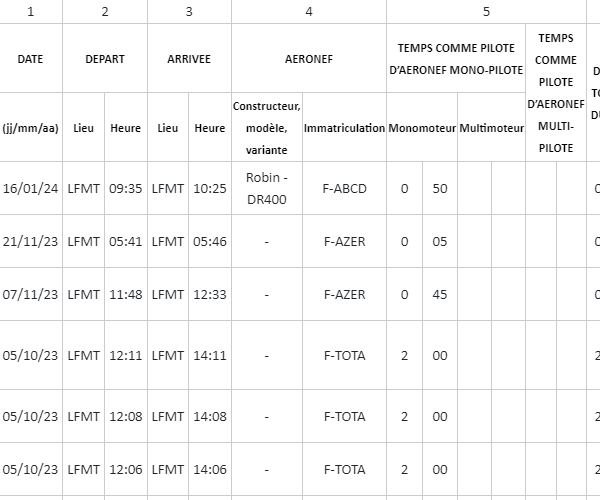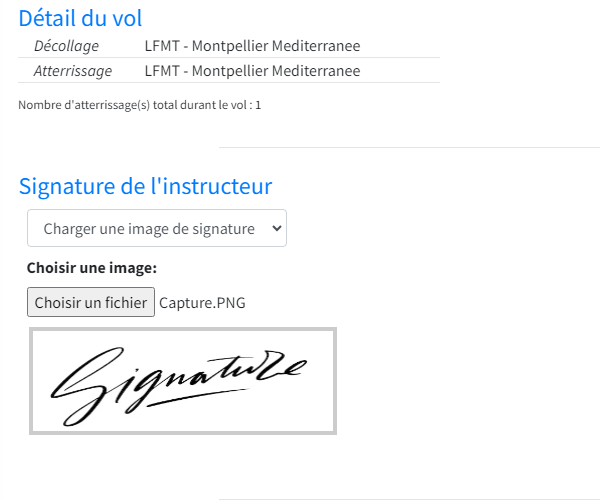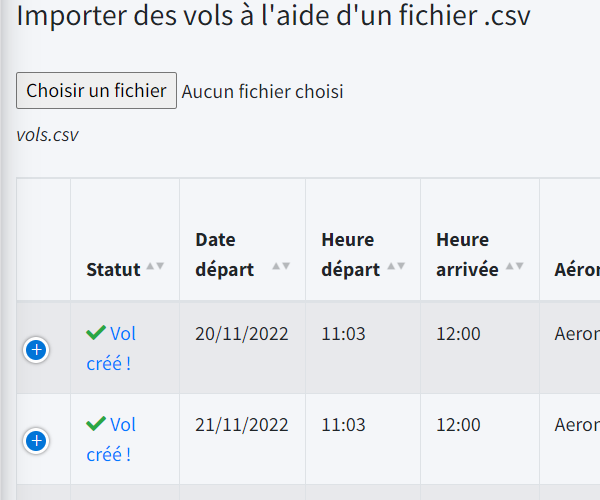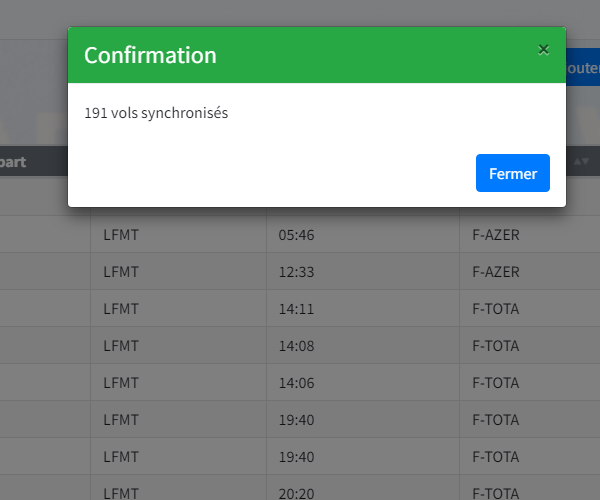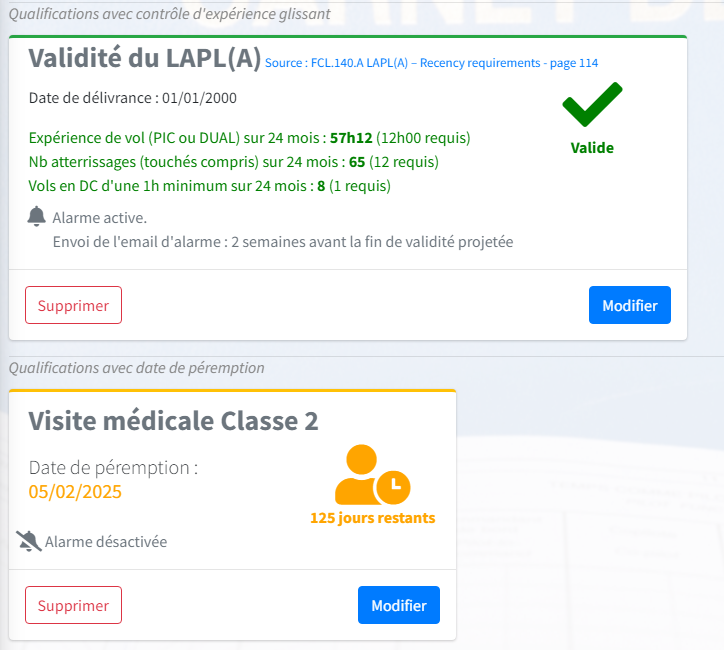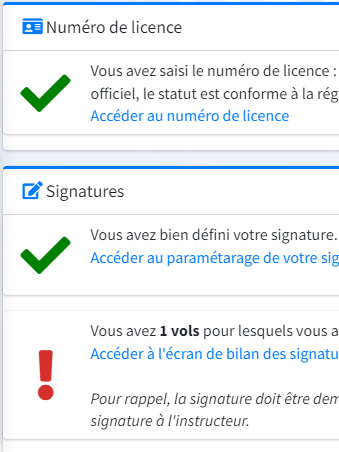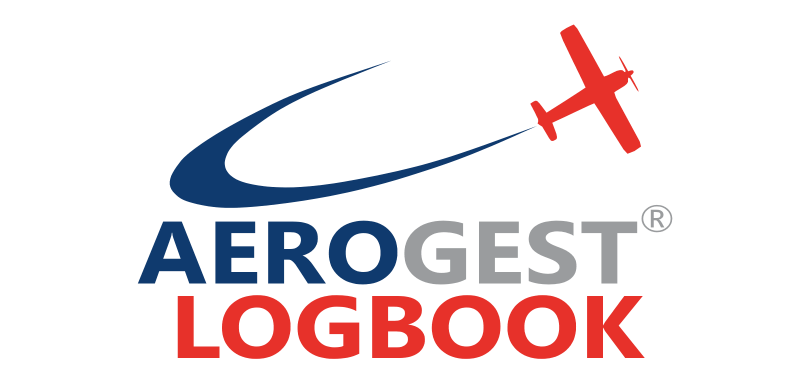| FCL.050 |
Solutions apportées 
|
|
(a) The record of the flights flown should contain at least the following information:
(1) personal details: name(s) and address of the pilot;
|
Aerogest-Logbook inclut dans l’export PDF du carnet de vol, deux pages introductives avec nom du pilote et le/les adresses du pilote. |
|
(2) for each flight:
(i) name(s) of PIC;
(ii) date of flight;
(iii) place and time of departure and arrival;
(iv) type, including make, model and variant, and registration of the aircraft;
(v) indication if the aircraft is SE or ME, if applicable;
(vi) total time of flight;
(vii) accumulated total time of flight
|
Toutes ces informations sont répertoriées dans la saisie de vol sur Aerogest-Logbook. Les informations sur les aéronefs (modèle, marque, SE/ME, etc.) sont traitées au niveau de chaque aéronef ce qui permet au pilote de ne pas ressaisir toutes ces données à chaque vol. L’export PDF du carnet de vol inclut les totaux progressifs des temps de vol demandés. |
|
(3) for each FSTD session, if applicable:
(i) type and qualification number of the training device;
(ii) FSTD instruction;
(iii) date;
(iv) total time of session;
(v) accumulated total time.
|
Aerogest-Logbook inclut la notion de simulateur au niveau du paramétrage de l’aéronef. L'export PDF au format FCL inclut les colonnes spécifiques pour les totaux de temps de vol sur simulateurs. |
|
(4) details on pilot function, namely PIC, including solo, SPIC and PICUS time, co-pilot, dual, FI or FE
|
Aerogest-Logbook prévoit tous les cas de rôle de pilote pour un vol dans toutes les conditions évoquées. |
|
(5) Operational conditions, namely if the operation takes place at night, or is conducted under instrument flight rules.
|
Aerogest-Lobgook permet de spécifier un vol ou une sous partie d’un vol en conditions opérationnelles Jour, conditions opérationnelles Nuit ou IFR. |
|
(b) Logging of time:
(1) PIC flight time:
(i) the holder of a licence may log as PIC time all of the flight time during which he or she is the PIC;
(ii) the applicant for or the holder of a pilot licence may log as PIC time all solo flight time, flight time as SPIC and flight time under supervision provided that such SPIC time and flight time under supervision are countersigned by the instructor;
(iii) the holder of an instructor certificate may log as PIC all flight time during which he or she acts as an instructor in an aircraft;
(iv) the holder of an examiner’s certificate may log as PIC all flight time during which he or she occupies a pilot’s seat and acts as an examiner in an aircraft;
(v) a co-pilot acting as PICUS on an aircraft on which more than one pilot is required under the type certification of the aircraft or as required by operational requirements provided that such PICUS time is countersigned by the PIC;
(vi) if the holder of a licence carries out a number of flights upon the same day returning on each occasion to the same place of departure and the interval between successive flights does not exceed 30 minutes, such series of flights may be recorded as a single entry.
|
Aerogest-Logbook permet au pilote d’enregistrer ses vols en tant que Commandant de Bord pour les titulaires d’une licence. Les élèves pilotes peuvent enregistrer leur vol en Double Commande avec un instructeur.
Un instructeur peut enregistrer ses vols en tant qu’Instructeur ou Examinateur. Un vol peut être déclaré en tant que SPIC ou PICUS. Il est recommandé sur Aerogest-Logbook de garder la notion d’une ligne par vol pour garder la cohérence du nombre de décollages et simplifier la gestion.
|
|
(2) co-pilot flight time: the holder of a pilot licence occupying a pilot seat asco-pilot may log all flight time as co-pilot flight time on an aircraft on which more than one pilot is required under the type certification of the aircraft, or the regulations under which the flight is conducted;
(3) cruise relief co-pilot flight time: a cruise relief co-pilot may log all flight time as co-pilot when occupying a pilot’s seat;
|
Aerogest-Logbook permet au pilote d’enregistrer ses vols en tant que Copilote. |
|
(4) instruction time: a summary of all time logged by an applicant for a licence or rating as flight instruction, instrument flight instruction, instrument ground time, etc., may be logged if certified by the appropriately rated or authorised instructor from whom it was received;
(5) PICUS flight time: provided that the method of supervision is acceptable to the competent authority, a co-pilot may log as PIC flight time flown as PICUS when all the duties and functions of PIC on that flight were carried out in such a way that the intervention of the PIC in the interest of safety was not required.
|
Aerogest-Logbook permet au pilote d’enregistrer ses vols en tant que Copilote. Un processus de signature des vols est proposé pour les cas obligatoires. |
|
(c) Format of the record:
(1) details of flights flown under commercial air transport may be recorded in an electronic format maintained by the operator. In this case an operator should make the records of all flights operated by the pilot, including differences and familiarisation training, available upon request to the flight crew member concerned;
(2) for other types of flights in aeroplanes, helicopters and powered-lift aircraft, the pilot should record the details of the flights flown in the following logbook format, which may be kept in electronic format. All data set out in (a) should be included.
(3) For sailplanes, balloons and airships, a suitable format, which may be electric, should be used. That format should contain the relevant items mentioned in (a) and additional information specific to the type of operation.
|
Aerogest-Online permet de sortir le format demandé colonne par colonne, ligne par ligne, avec les mêmes sous-totaux et totaux. Le format est exportable à tout moment par le pilote. |
|
(d) FCL.050 requires holders of a pilot licence to record details of all flights flown. This logbook enables pilot licence holders to record flying experience in a manner which will facilitate this process while providing a permanent record of the licence holders flying.
Pilots who fly regularly aeroplanes and helicopters or other aircraft categories are recommended to maintain separate logbooks for each aircraft category.
|
Aerogest-Logbook permet le suivi complet de l’expérience du pilote. Le pilote volant sur plusieurs types d'aéronef peut enregistrer tous ses vols dans Aerogest-Logbook tout en n’exportant que les vols concernant un type d’aéronef (Avion, ULM, etc.) pour suivre la recommandation mentionnée. |
|
(e) Flight crew logbook entries should be made as soon as practicable after any flight undertaken. All entries in the flight crew logbook should comply with the following:
(1) in case of paper records, they should be made in ink or indelible pencil; or
(2) in case of electronic records, they should be made and kept in a way to be readily available at the request of a competent authority, and contain
all relevant items that are mentioned in (a), certified by the pilot, and in a format acceptable by the competent authority.
|
Le pilote peut saisir un vol à tout moment dans Aerogest-Logbook. Le vol peut être créé et synchronisé automatiquement depuis un système de gestion d’aéroclub Aerogest-Online pour éviter les ressaisies et les erreurs inhérentes.
Un vol reste modifiable par le pilote afin d’éviter les erreurs de saisies impactant son expérience. Un vol signé par un tiers ne peut plus être modifié. Aerogest-Logbook permet de gérer tous les données mentionnées dans le paragraphe (a).
|
|
(f) The particulars of every flight in the course of which the holder of a flight crew licence acts as a member of the operating crew of an aircraft are to be recorded in the appropriate columns using one line for each flight,
provided that if an aircraft carries out a number of flights upon the same day returning on each occasion to the same place of departure and the interval between successive flights does not exceed 30 minutes, such series of flights may be recorded as a single entry.
|
Le pilote est libre de la façon dont il saisit ses vols dans Aerogest-Logbook. Il est recommandé sur Aerogest-Logbook de garder la notion d’une ligne par vol pour garder cohérence du nombre de décollages et simplifier la gestion. |
|
(g) Flight time is recorded:
(1) for aeroplanes, touring motor gliders and powered-lift aircraft, from the moment an aircraft first moves to taking off until the moment it finally comes to rest at the end of the flight;
(2) for helicopters, from the moment a helicopter’s rotor blades start turning until the moment the helicopter finally comes to rest at the end of the flight, and the rotor blades are stopped;
(3) for airships, from the moment an airship is released from the mast to taking off until the moment the airship finally comes to rest at the end of the flight, and is secured on the mast;
|
Dans Aerogest-Logbook, le pilote saisit son heure de départ et son heure d’arrivée librement. Il est responsable de saisir les valeurs correspondantes à la méthode officielle de calcul du temps de vol sur son aéronef. |
|
(h) When an aircraft carries two or more pilots as members of the operating crew, one of them shall, before the flight commences, be designated by the operator as the aircraft PIC, according to operational requirements,
who may delegate the conduct of the flight to another suitably qualified pilot. All flying carried out as PIC is entered in the logbook as ‘PIC’. A pilot flying as ‘PICUS’ or ‘SPIC’ enters flying time as ‘PIC’ but all such entries are to be certified by the PIC or FI in the ‘Remarks’ column of the logbook.
|
Aerogest-Logbook inclut un système de signature de vol pour l’instructeur (ou le PIC). La signature collectée est apposée sur l’export PDF du carnet de vol dans la colonne Remarques. Le pilote est responsable de fournir le bon email pour la signature de l’instructeur ou du pilote principal. |
|
(i) Notes on recording of flight time:
(1) column 1: enter the date (dd/mm/yy) on which the flight commences;
(2) column 2 or 3: enter the place of departure and destination either in full or the internationally recognised three or four letter designator. All times should be in UTC;
(3) column 5: indicate whether the operation was SP or MP, and for SP operation whether SE or ME;
(4) column 6: total time of flight may be entered in hours and minutes or decimal notation as desired;
(5) column 7: enter the name(s) of PIC or SELF as appropriate;
(6) column 8: indicate the number of landings as pilot flying by day or night;
(7) column 9: enter flight time undertaken at night or under instrument flight rules if applicable;
(8) column 10: pilot function time:
(i) enter flight time as PIC, SPIC and PICUS as PIC;
|
Aerogest-Logbook respecte l’intégralité de ces recommandations de format. |
|
(ii) all time recorded as SPIC or PICUS is countersigned by the aircraft PIC/FI in the ‘remarks’ (column 12);
|
La case remarque est libre de complétion par le pilote. Aerogest-Logbook inclut un système de signature de vol. |
|
(9) column 11: FSTD:
(i) for any FSTD enter the type of aircraft and qualification number of the device. For other flight training devices enter either FNPTI or FNPT II as appropriate;
(ii) total time of session includes all exercises carried out in the device, including pre- and after-flight checks;
(iii) enter the type of exercise performed in the ‘remarks’ (column 12), for example operator proficiency check, revalidation.
|
Aerogest-Logbook inclut la notion de simulateur au niveau de chaque aéronef. La case remarque est libre de complétion par le pilote. |
|
(10) column 12: the ‘remarks’ column may be used to record details of the flight at the holder’s discretion. The following entries, however, should always be made:
(i) instrument flight time undertaken as part of the training for a licence or rating;
(ii) details of all skill tests and proficiency checks;
(iii) signature of PIC if the pilot is recording flight time as SPIC or PICUS;
(iv) signature of instructor if flight is part of an SEP or TMG class rating revalidation.
(j) When each page is completed, accumulated flight time or hours should be entered in the appropriate columns and certified by the pilot in the ‘remarks’ column.
|
La case remarque est libre de complétion par le pilote. La signature collectée est apposée sur l’export PDF du carnet de vol dans la colonne Remarques. |
